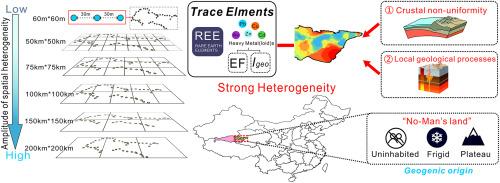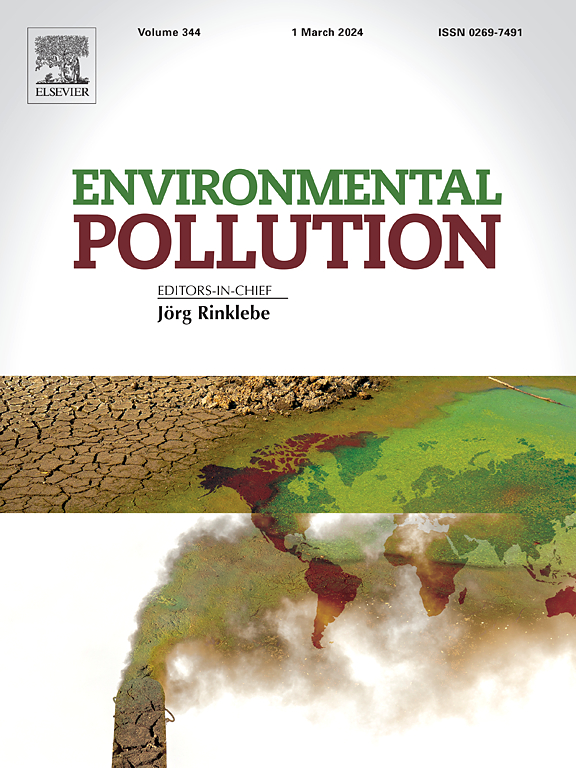IF 7.6
2区 环境科学与生态学
Q1 ENVIRONMENTAL SCIENCES
引用次数: 0
摘要
地表土壤中微量元素地球化学背景的空间异质性对准确评估人为因素对土壤污染的影响构成了巨大挑战。为了评估微量元素丰度的自然变化,研究人员测定了中国西部自然保护区内 153 个地点的 50 种微量元素的组成和空间分布。虽然稀土元素和重金属(loid)的含量与大陆地壳的组成密切相关,但这些元素的空间异质性从中等到极高不等。变异系数(CV)表明,在 50 种微量元素中,有 46 种显示出中等至高度的空间异质性(10% <;CV <;100%),而其余元素则显示出极端的空间异质性(CV >;100%)。值得注意的是,嗜铬元素表现出特别高的空间异质性,而且微量元素丰度的空间异质性随着评估的地理空间尺度而增加。将不同地理空间尺度下的微量元素含量与成岩元素 Ti 的含量进行归一化处理后发现,元素丰度的内在地壳异质性以及区域地质过程导致的元素优先富集或贫化是形成原始表层土壤中微量元素空间分布差异的主要因素。微量元素分布的显著空间异质性及其分形特征对于评估微量元素对地表土壤的污染以及根据区域背景值减去人类活动的贡献具有重要意义。本文章由计算机程序翻译,如有差异,请以英文原文为准。

Fractal Spatial Heterogeneity of Trace Element Abundance in Pristine Surface Soils: Implications for Pollution Assessment and Source Apportionment
The spatial heterogeneity of trace element geochemical backgrounds in surface soils poses a significant challenge for accuratly assessing the anthropogenic contributions to soil pollution. To evaluate the natural variation in trace element abundance, the composition and spatial distribution of 50 trace elements across 153 sites in the Hoh Xil Nature Reserve, a pristine region in western China, were determined. While the contents of the rare earth elements and heavy metal(loid)s closely mirror the composition of continental crust, moderate to extremely high spatial heterogeneity was found for these elements. The coefficients of variation (CV) indicate that 46 of the 50 trace elements display moderate to high spatial heterogeneity (10% < CV < 100%), while the remaining ones show extreme spatial heterogeneity (CV > 100%). Notably, the chalcophile elements exhibit particularly high spatial heterogeneity, and the spatial heterogeneity in trace element abundance increased with the geospatial scale of assessment. Normalization of the contents of trace elements with those of rock-forming element, Ti, under different geospatial scales reveals that the intrinsic crustal heterogenity in elemental abundance and the preferential enrichment or depletion of elements due to regional geological processes are the primary factors shaping the spatial viariation in their distribution in the pristine surface soils. The significant spatial heterogeneity in the distribution of trace elements and its fractal characteristics have important implications for evaluating the pollution of surface soils by trace elements and apportioning the contribution of anthropgenic activities based on subtraction of the regional background values.
求助全文
通过发布文献求助,成功后即可免费获取论文全文。
去求助
来源期刊

Environmental Pollution
环境科学-环境科学
CiteScore
16.00
自引率
6.70%
发文量
2082
审稿时长
2.9 months
期刊介绍:
Environmental Pollution is an international peer-reviewed journal that publishes high-quality research papers and review articles covering all aspects of environmental pollution and its impacts on ecosystems and human health.
Subject areas include, but are not limited to:
• Sources and occurrences of pollutants that are clearly defined and measured in environmental compartments, food and food-related items, and human bodies;
• Interlinks between contaminant exposure and biological, ecological, and human health effects, including those of climate change;
• Contaminants of emerging concerns (including but not limited to antibiotic resistant microorganisms or genes, microplastics/nanoplastics, electronic wastes, light, and noise) and/or their biological, ecological, or human health effects;
• Laboratory and field studies on the remediation/mitigation of environmental pollution via new techniques and with clear links to biological, ecological, or human health effects;
• Modeling of pollution processes, patterns, or trends that is of clear environmental and/or human health interest;
• New techniques that measure and examine environmental occurrences, transport, behavior, and effects of pollutants within the environment or the laboratory, provided that they can be clearly used to address problems within regional or global environmental compartments.
 求助内容:
求助内容: 应助结果提醒方式:
应助结果提醒方式:


